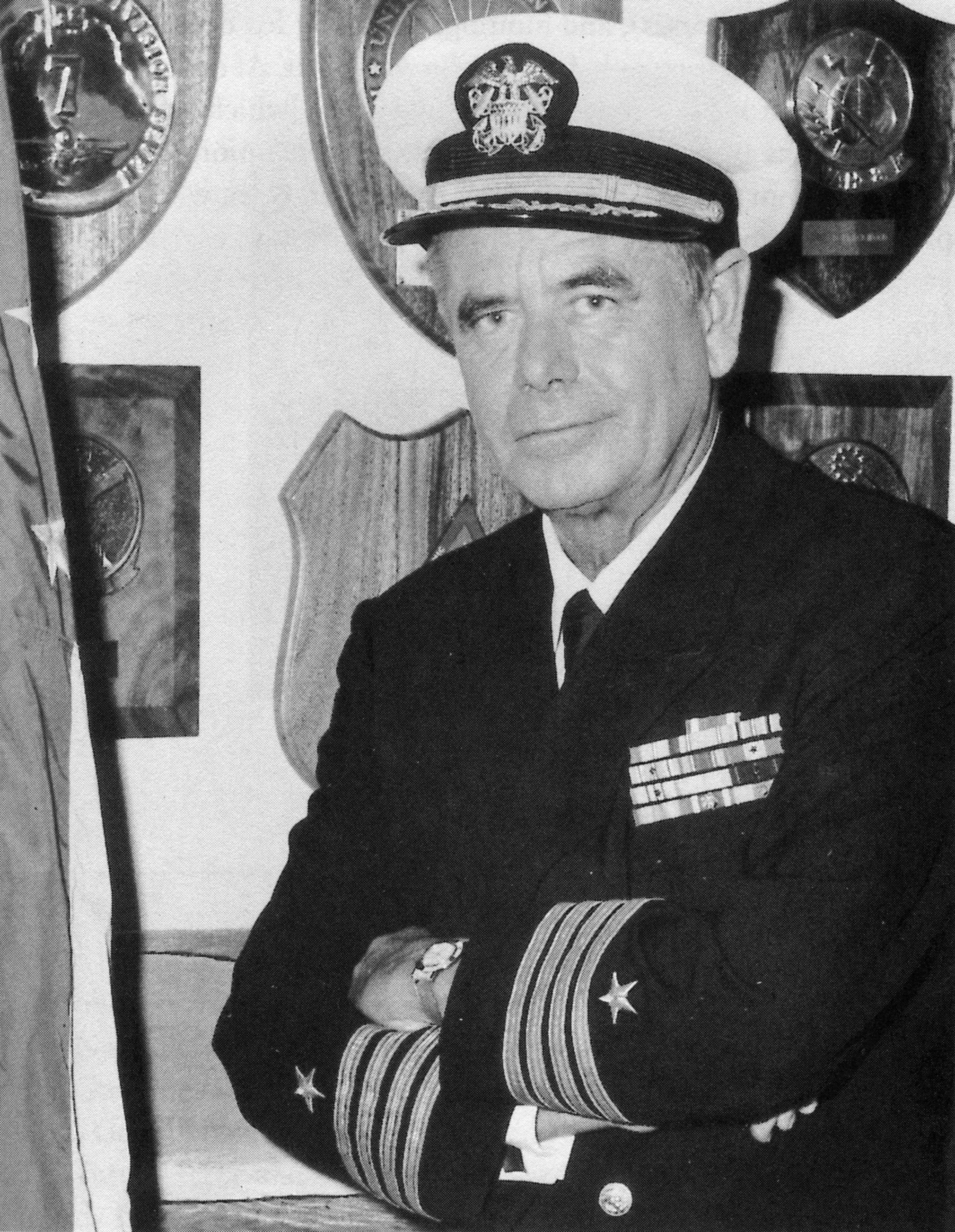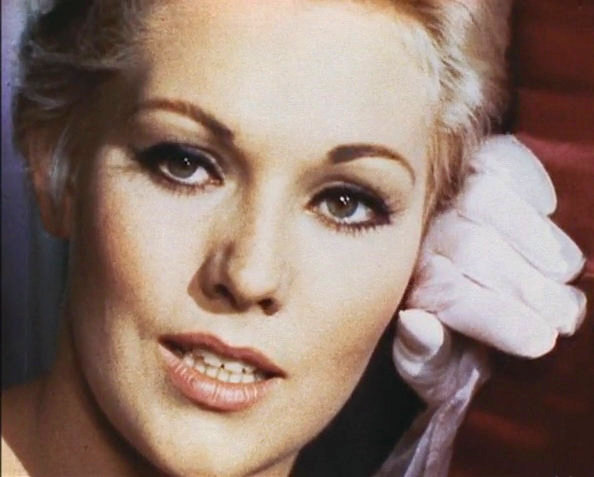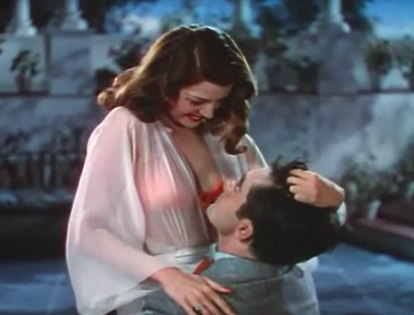|
Rita Hayworth
Rita Hayworth (born Margarita Carmen Cansino; October 17, 1918May 14, 1987) was an American actress, dancer and producer. She achieved fame during the 1940s as one of the era's top stars, appearing in 61 films over 37 years. The press coined the term "The Love Goddess" to describe Hayworth after she had become the most glamorous screen idol of the 1940s. She was the top pin-up girl for GIs during World War II. Hayworth is perhaps best known for her performance in the 1946 film noir ''Gilda'', opposite Glenn Ford, in which she played the ''femme fatale'' in her first major dramatic role. She is also known for her performances in ''Only Angels Have Wings'' (1939), ''The Strawberry Blonde'' (1941), '' Blood and Sand'' (1941), ''The Lady from Shanghai'' (1947), '' Pal Joey'' (1957), and ''Separate Tables'' (1958). Fred Astaire, with whom she made two films, ''You'll Never Get Rich'' (1941) and ''You Were Never Lovelier'' (1942), once called her his favorite dance partner. She also ... [...More Info...] [...Related Items...] OR: [Wikipedia] [Google] [Baidu] |
New York City
New York, often called New York City or NYC, is the most populous city in the United States. With a 2020 population of 8,804,190 distributed over , New York City is also the most densely populated major city in the United States, and is more than twice as populous as second-place Los Angeles. New York City lies at the southern tip of New York State, and constitutes the geographical and demographic center of both the Northeast megalopolis and the New York metropolitan area, the largest metropolitan area in the world by urban landmass. With over 20.1 million people in its metropolitan statistical area and 23.5 million in its combined statistical area as of 2020, New York is one of the world's most populous megacities, and over 58 million people live within of the city. New York City is a global cultural, financial, entertainment, and media center with a significant influence on commerce, health care and life sciences, research, technology, education, ... [...More Info...] [...Related Items...] OR: [Wikipedia] [Google] [Baidu] |
Glenn Ford
Gwyllyn Samuel Newton "Glenn" Ford (May 1, 1916 – August 30, 2006) was a Canadian-American actor who often portrayed ordinary men in unusual circumstances. Ford was most prominent during Hollywood's Golden Age as one of the biggest box-office draws of the 1940s, 1950s, and 1960s, who had a career that lasted more than 50 years. Although he played in many genres of movies, some of his most significant roles were in the film noirs '' Gilda'' (1946) and '' The Big Heat'' (1953), and the high school angst film ''Blackboard Jungle'' (1955). However, it was for comedies or westerns which he received acting laurels, including three Golden Globe Nominations for Best Actor in a Comedy movie, winning for ''Pocketful of Miracles'' (1961). He also played a supporting role as Clark Kent's adoptive father, Jonathan Kent, in ''Superman'' (1978). Five of his films have been selected for the National Film Registry by the Library of Congress as being "culturally, historically or aestheticall ... [...More Info...] [...Related Items...] OR: [Wikipedia] [Google] [Baidu] |
Gene Kelly
Eugene Curran Kelly (August 23, 1912 – February 2, 1996) was an American actor, dancer, singer, filmmaker, and choreographer. He was known for his energetic and athletic dancing style and sought to create a new form of American dance accessible to the general public, "dance for the common man." He starred in, choreographed, and co-directed with Stanley Donen some of the most well-regarded musical films of the 1940s and 1950s. Kelly is best known for his performances in '' An American in Paris'' (1951), which won the Academy Award for Best Picture, '' Singin' in the Rain'' (1952), which he and Donen directed and choreographed, and other musical films of that era such as '' Cover Girl'' (1944) and '' Anchors Aweigh'' (1945), for which he was nominated for an Academy Award for Best Actor. '' On the Town'' (1949), which he co-directed with Donen, was his directorial debut. Later in the 1950s, as musicals waned in popularity, he starred in ''Brigadoon'' (1954) and '' It's Always ... [...More Info...] [...Related Items...] OR: [Wikipedia] [Google] [Baidu] |
Cover Girl (film)
''Cover Girl'' is a 1944 American musical romantic comedy film directed by Charles Vidor and starring Rita Hayworth and Gene Kelly. The film tells the story of a chorus girl given a chance at stardom when she is offered an opportunity to be a highly paid cover girl. It was one of the most popular musicals of the war years. Primarily a showcase for Hayworth, the film has lavish modern and 1890s costumes, eight dance routines for Hayworth, and songs by Jerome Kern and Ira Gershwin, including "Long Ago (and Far Away)". Plot Rusty is a very lovely and beautiful chorus girl at a Brooklyn nightclub run by her boyfriend Danny McGuire. Fellow showgirl Maurine Martin enters a contest to be on the cover of ''Vanity'' magazine, so Rusty tries out as well. When Maurine is given a lukewarm evaluation by Cornelia Jackson, she sabotages Rusty's chances, giving her terrible advice on how to act toward Cornelia. Cornelia's boss, magazine editor John Coudair, decides to check out Maurine at Dann ... [...More Info...] [...Related Items...] OR: [Wikipedia] [Google] [Baidu] |
Technicolor
Technicolor is a series of Color motion picture film, color motion picture processes, the first version dating back to 1916, and followed by improved versions over several decades. Definitive Technicolor movies using three black and white films running through a special camera (3-strip Technicolor or Process 4) started in the early 1930s and continued through to the mid-1950s when the 3-strip camera was replaced by a standard camera loaded with single strip 'monopack' color negative film. Technicolor Laboratories were still able to produce Technicolor prints by creating three black and white matrices from the Eastmancolor negative (Process 5). Process 4 was the second major color process, after Britain's Kinemacolor (used between 1908 and 1914), and the most widely used color process in Cinema of the United States, Hollywood during the Golden Age of Hollywood. Technicolor's #Process 4: Development and introduction, three-color process became known and celebrated for its highly s ... [...More Info...] [...Related Items...] OR: [Wikipedia] [Google] [Baidu] |
You Were Never Lovelier
''You Were Never Lovelier'' is a 1942 American musical romantic comedy film directed by William A. Seiter and starring Fred Astaire and Rita Hayworth. The supporting cast also features Adolphe Menjou, Xavier Cugat and Adele Mara. The music was composed by Jerome Kern and the lyrics by Johnny Mercer. The picture was released by Columbia Pictures and includes the elaborate "Shorty George" song and dance sequence. The film, a Hollywood remake of the 1941 Argentine romantic comedy '' Los martes, orquídeas'' (''On Tuesdays, Orchids''), is set in Buenos Aires. Plot Robert "Bob" Davis (Fred Astaire) is a well-known American dancer with a weakness for betting on the horses. After he loses his money gambling in Buenos Aires, he goes looking for a job with Eduardo Acuña, the wealthy owner of a nightclub. Acuña, however, does not wish to see him. Bob's friend, bandleader Xavier Cugat, invites him to perform at the wedding of Acuña's eldest daughter, Julia, Acuña insists his daughters m ... [...More Info...] [...Related Items...] OR: [Wikipedia] [Google] [Baidu] |
You'll Never Get Rich
''You'll Never Get Rich'' is a 1941 Hollywood musical comedy film with a wartime theme directed by Sidney Lanfield and starring Fred Astaire, Rita Hayworth, Robert Benchley, Cliff Nazarro, with music and lyrics by Cole Porter. The title stems from an old Army song which includes lyrics "You'll never get rich / by digging a ditch / you're in the Army now!" This was Hayworth's first starring role in a big budgeted film from her home studio Columbia Pictures. While the film was in production, ''Life'' magazine put her on its cover, and featured inside a photo of Hayworth kneeling on a bed in a nightgown, which soon became one of the most widely distributed pin-ups of all time. Hayworth cooperated enthusiastically with Astaire's intense rehearsal habits, and was later to remark: "I guess the only jewels in my life are the pictures I made with Fred Astaire." The picture was very successful at the box office, turning Hayworth into a major star, and provided a welcome boost to Astaire ... [...More Info...] [...Related Items...] OR: [Wikipedia] [Google] [Baidu] |
Fred Astaire
Fred Astaire (born Frederick Austerlitz; May 10, 1899 – June 22, 1987) was an American dancer, choreographer, actor, and singer. He is often called the greatest dancer in Hollywood film history. Astaire's career in stage, film, and television spanned 76 years. He starred in more than 10 Broadway and West End musicals, made 31 musical films, four television specials, and numerous recordings. As a dancer, he was known for his uncanny sense of rhythm, creativity, and tireless perfectionism. Astaire's most memorable dancing partnership was with Ginger Rogers, whom he co-starred with in 10 Hollywood musicals during the classic age of Hollywood cinema. Astaire and Rogers starred together in ''Top Hat'' (1935), '' Swing Time'' (1936), and ''Shall We Dance'' (1937). Astaire's fame grew in films like ''Holiday Inn'' (1942), '' Easter Parade'' (1948), '' The Band Wagon'' (1953), '' Funny Face'' (1957), and ''Silk Stockings'' (1957). The American Film Institute named Astaire the ... [...More Info...] [...Related Items...] OR: [Wikipedia] [Google] [Baidu] |
Separate Tables (film)
''Separate Tables'' is a 1958 American drama film starring Rita Hayworth, Deborah Kerr, David Niven, Burt Lancaster, and Wendy Hiller, based on two one-act plays by Terence Rattigan that were collectively known by this name. Niven and Hiller won Academy Awards for Best Actor and Best Supporting Actress respectively for their performances. The picture was directed by Delbert Mann and adapted for the screen by Rattigan, John Gay and an uncredited John Michael Hayes. Mary Grant and Edith Head designed the film's costumes. Plot The film is set in the Hotel Beauregard in Bournemouth on the south coast of England. Major David Angus Pollock (David Niven) tries but fails to hide an article about himself in the ''West Hampshire Weekly News''. His attempt to keep the article from the eyes of the other guests at the residential hotel only succeeds in heightening their awareness of it, particularly the strict Mrs Railton-Bell ( Gladys Cooper) and the more relaxed and compassionat ... [...More Info...] [...Related Items...] OR: [Wikipedia] [Google] [Baidu] |
Pal Joey (film)
''Pal Joey'' is a 1957 American musical comedy film directed by George Sidney, loosely adapted from the Rodgers and Hart musical play of the same name, and starring Rita Hayworth, Frank Sinatra, and Kim Novak. Jo Ann Greer sang for Hayworth, as she had done previously in ''Affair in Trinidad'' (1952) and '' Miss Sadie Thompson'' (1953). Novak's singing voice was dubbed by Trudy Stevens. The choreography was managed by Hermes Pan. Nelson Riddle handled the musical arrangements for the Rodgers and Hart standards " The Lady Is a Tramp", "I Didn't Know What Time It Was", " I Could Write a Book", and "There's a Small Hotel". Sinatra won the Golden Globe Award for Best Actor - Motion Picture Musical or Comedy for his role as the wise-cracking, hard-bitten Joey Evans. Along with its strong box-office success, ''Pal Joey'' earned four Academy Award nominations and one Golden Globe Award nomination. ''Pal Joey'' is one of Sinatra's few post-''From Here to Eternity'' films in which he ... [...More Info...] [...Related Items...] OR: [Wikipedia] [Google] [Baidu] |
The Lady From Shanghai
''The Lady from Shanghai'' is a 1947 American film noir directed by Orson Welles (uncredited) and starring Welles, his estranged wife Rita Hayworth, and Everett Sloane. It is based on the novel ''If I Die Before I Wake'' by Sherwood King. Although it initially received mixed reviews, it has grown in stature over the years, and many critics have praised its set designs and camerawork. In 2018, the film was selected for preservation in the United States National Film Registry by the Library of Congress as being "culturally, historically, or aesthetically significant." Plot Irish sailor Michael O'Hara meets the beautiful blonde Elsa as she rides a horse-drawn coach in Central Park. Three hooligans waylay the coach. Michael rescues Elsa and escorts her home. Michael reveals he is a seaman and learns Elsa and her husband, disabled criminal defense attorney Arthur Bannister, are newly arrived in New York City from Shanghai. They are on their way to San Francisco via the Panama Canal. ... [...More Info...] [...Related Items...] OR: [Wikipedia] [Google] [Baidu] |
Blood And Sand (1941 Film)
''Blood and Sand'' is a 1941 American romantic Technicolor film directed by Rouben Mamoulian and starring Tyrone Power, Linda Darnell, Rita Hayworth, and Nazimova. It was produced by 20th Century Fox and was based on the 1908 Spanish novel, which was critical of bullfighting, ''Blood and Sand'' (''Sangre y arena''), by Vicente Blasco Ibanez. The supporting cast features Anthony Quinn, Lynn Bari, Laird Cregar, J. Carrol Naish, John Carradine and George Reeves. Rita Hayworth's singing voice was dubbed by Gracilla Pirraga. The film has two versions of ''Blood and Sand:'' a 1922 version produced by Paramount Pictures and starring Rudolph Valentino; as well as a 1916 version filmed by Blasco Ibanez with the help of Max André; in addition to a later 1989 version starring Christopher Rydell and Sharon Stone. This was the fourth and last in which Tyrone Power and Linda Darnell worked together. The others were ''Day-Time Wife'' (1939), ''Brigham Young'' (1940), and '' The Mark o ... [...More Info...] [...Related Items...] OR: [Wikipedia] [Google] [Baidu] |








